Luna and Vaughn Talk the Star Crossed Lovers of Alex + Ada
We dig into the book with the team of the acclaimed Image title
My favorite story in comics the past couple years has been Jonathan Luna and Sarah Vaughn’s Alex + Ada, a story from Image Comics that effortlessly blends romance with a civil rights movement set in a very tranquil vision of the future. I can’t help it. I’m a hopeless romantic, and a story like that one cuts straight to my heart. Over the fifteen issue story, Luna and Vaughn made readers laugh, cry, rage, smile and many other things on the emotional scale that Pixar’s Inside Out undoubtedly covered, and with last week’s issue, it has now wrapped with a beautiful finale. I won’t get into it, but the final issue of the series was a heartfelt, expertly crafted example of how to end a series well.
Naturally, as Alex + Ada’s preeminent fanboy, I reached out to the creative team to talk about the story as a whole, how it developed, whether the ending was what they always envisioned it as, future plans, and a whole lot more. It acts as a commentary of sorts on the series, as the first half of the questions were asked before reading the finale while the latter came up after the finale. Take a read below, and if you haven’t read it yet, this is a book that heartily earns the SKTCHD stamp of approval.
Spoilers for the whole series but mostly the finale will be discussed below. If you haven’t read the series yet and want to, I’d advise against reading this interview.
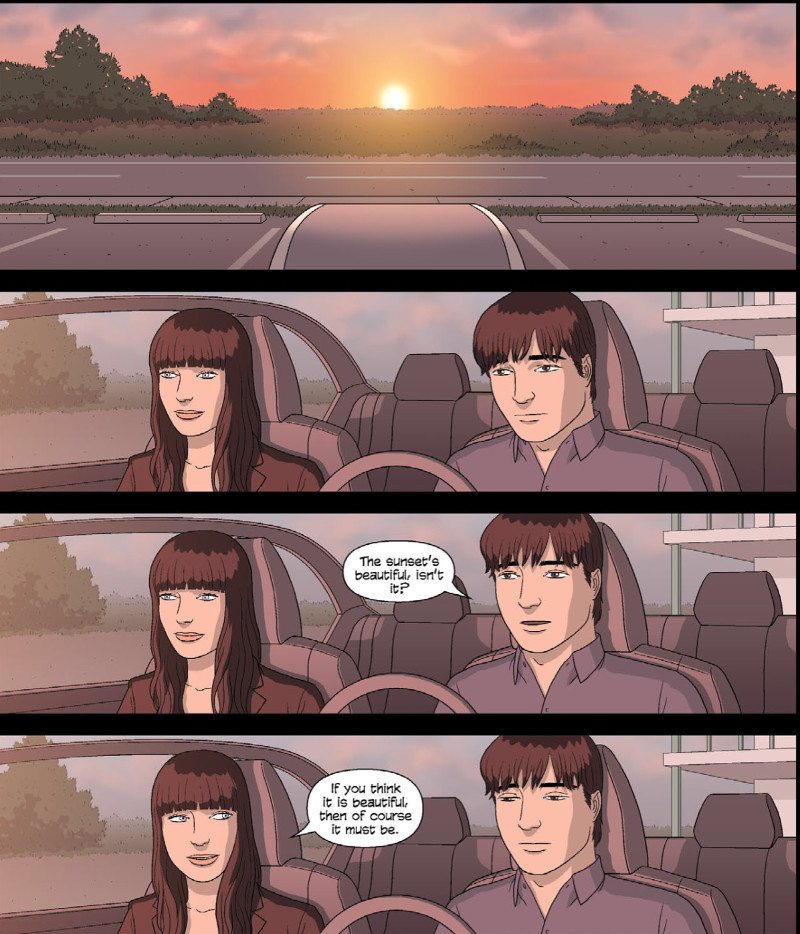 One of my favorite parts about the book was how you would take moments from previous issues and have them pay off subtly later on. Particularly, I loved Alex asking Ada – pre-sentience – about the sunset and her having no response. Then an issue later, after she was woken up she said the sunset was beautiful. It’s those moments that really helped make this book a special one. When the two of you wrote this series, was it really an issue-by-issue approach, did you tackle it by trade, or what?
One of my favorite parts about the book was how you would take moments from previous issues and have them pay off subtly later on. Particularly, I loved Alex asking Ada – pre-sentience – about the sunset and her having no response. Then an issue later, after she was woken up she said the sunset was beautiful. It’s those moments that really helped make this book a special one. When the two of you wrote this series, was it really an issue-by-issue approach, did you tackle it by trade, or what?
Jonathan: We actually planned out the whole series from the beginning. You can’t start walking unless you know the destination first. Ultimately, it makes the story more cohesive. However, everything wasn’t completely concrete when we plotted it out. We left it a bit loose so that it was still organic and fun for us as we continued on. But, yeah, I’m really glad we have moments like what you described in this series.
Sarah: We planted a lot of seeds, but funnily enough, a few of those connections were created in the moment. We had an end goal, and stopping points along the way, but a lot of the path was unknown. A few points got taken out, too. That was always exciting and scary, in figuring out how to make changes on something not working that you already set up the blocks for.
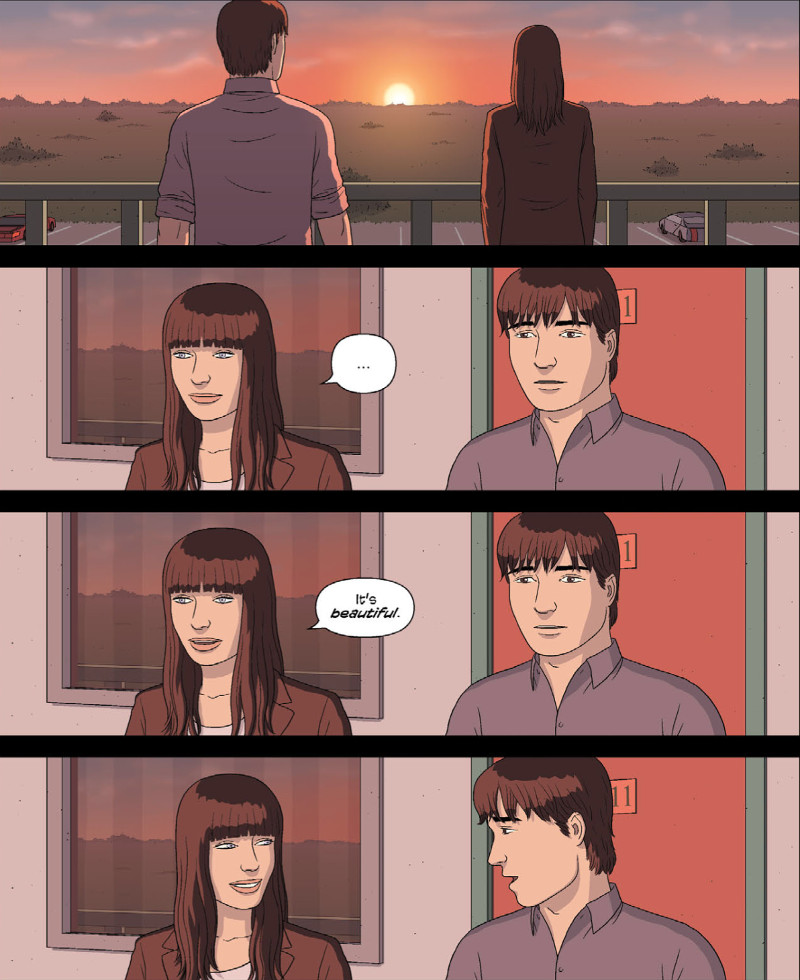 For the scripts, how did the two of you work together? Was it mostly you taking the lead, Sarah, or was it very much a collaborative effort?
For the scripts, how did the two of you work together? Was it mostly you taking the lead, Sarah, or was it very much a collaborative effort?
Sarah: To make it a complicated answer, it’s a combination of both. Jon and I work extremely closely. It’s definitely a co-writership, and though the balance isn’t necessarily equal when it comes to the actual writing, the final script is absolutely both of ours — you really can’t untangle it. To give the whole picture, Jon wrote the first draft of issue one, and we worked together on rewrites. After issue one, the process switched up a bit. He started drawing pages and needed to focus on the art, so I took the lead on the first drafts. Jon would read them and come back to discuss changes, additions, etc. I’d then rewrite, send another draft, and we’d work on the next round of edits. Thank God for Google Docs. I don’t know how we could have done it otherwise.
Jonathan: I was amused about how appropriate it was to use technology in writing a script for this sci-fi story.
The story is primarily told from Alex’s perspective, but Ada goes through arguably a more significant arc. Would you say this book is Alex’s story, Ada’s, or is it truly a look at how lives change when you add a plus sign between them?
Jonathan: Ada was, in a sense, a newborn, so she absolutely has much more growth. Alex grows too, but it probably doesn’t seem as much, in relation to Ada. The book is called ALEX + ADA, and it was definitely our intention to make it a story about the two of them, separately and together. We tried our best to treat them equally as characters, despite their differences, which are major ones.
Sure, we aren’t dealing with issues of robot sentience, but at the base of it, Ada’s human rights are the core of the story, and they aren’t unlike many groups in the real world. Would you say there is any real world allegory to the story?
Sarah: Yes, definitely. Humans have a long history of being terrible, and there’s no way around that. When Jon and I first started talking about the world of Alex + Ada, everything we built was based around exploring a meaningful and healthy relationship between a human and an android. That meant the android had to be sentient to reciprocate any kind of attachment. And the idea of sentient artificial intelligence opens up a level of change, fear, and unknown that humanity hasn’t handled well in the past and the present.
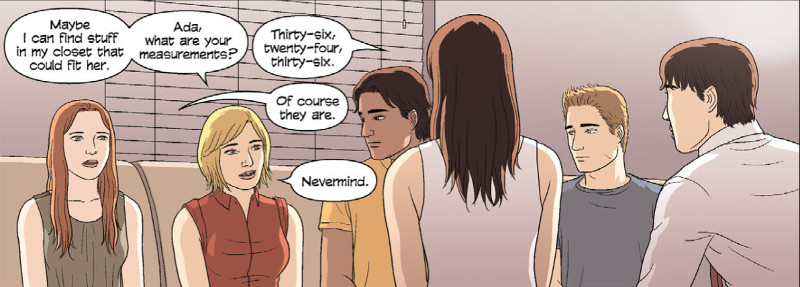
Alex’s core group of friends – Emily, Teji, Isabel and Jacob – are important to the story, but they all fill a slightly different role in terms of how humanity may react to robot sentience. How important was it to have them as both characters that humanize Alex, but also ones that show off the range of emotions that might come from someone like Ada coming to exist?
Jonathan: It was important for us that Alex had friends and a social life in the beginning. And he’s able to interact with women. He didn’t need an android. But he was depressed. And he pretty much hid in a hole that he created for himself.
Sarah: It all comes back to building an environment for that healthy and meaningful relationship. Alex’s social life is a huge factor for his side of that. If it comes across that he’s with Ada out of desperation or apathy regarding human romantic relationships, then it just doesn’t feel right.
Jonathan: In terms of how his friends represented a range of emotions, that was definitely intentional. We wanted Ada’s presence to either strengthen or weaken relationships. And we wanted the friends’ points of view to represent what was out in the world.
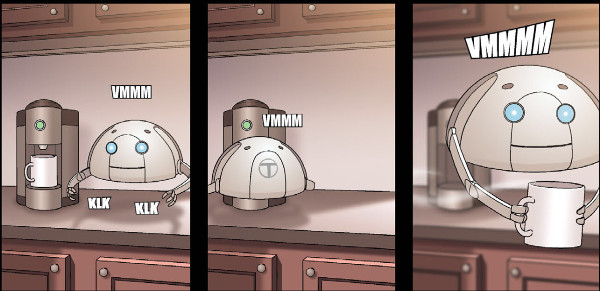
There were a lot of moments in the series before the finale that really crushed our hearts, but let’s be honest; the one that really broke us was Jacob grievously injuring Otto. First off, how dare you. Second off, did you deliberately try to make readers care more for the robotic characters while giving the people themselves some of the more inhuman qualities? Was that contrast by design?
Sarah: Absolutely. And–for the record–I love Otto (whom Jon completely created, by the way, from conception to design to name). I want to hug him and squish him and call him “George”. I also find myself immediately making Otto male, for some really bizarre reason, but maybe that’s just the character letting me know that’s the pronoun he prefers.
Now that I sound insane…I’d also argue that a lot of the “inhuman qualities” you’re referring to are actually quite human.
At the heart of the story is really a question of identity and individuality. Who are we really and what defines us? What interested you two so much about that idea?
Sarah: For me, it’s the first question I ask when I think about sentient artificial intelligence, and the possibilities of a new self-aware being. It’s also a huge pondering for ourselves, as humans. Who are we? What are we capable of? They so easily go hand in hand when it’s a human who creates the artificial intelligence.
Jonathan: Your question alone is what makes it interesting. What is it that makes us us? Which parts come from nature or nurture? It’s very thought-provoking. In the book, we say that a big part of it is experiences. The crazy thing about that is many of the experiences in our lives come to us randomly. We can’t control which come to us. Can we totally control who we become?
Aesthetically, the story fits your style Jonathan, as this robot filled future is very clean, very sterile and very low impact for the people within it. It’s also very expressive and does a lot to reduce the need for heavy dialogue, which is especially important for a book that loneliness is such a key factor in. How did your art style adjust your scripting approach, if at all? Did its minimalist nature drive a need for more minimal dialogue as well?
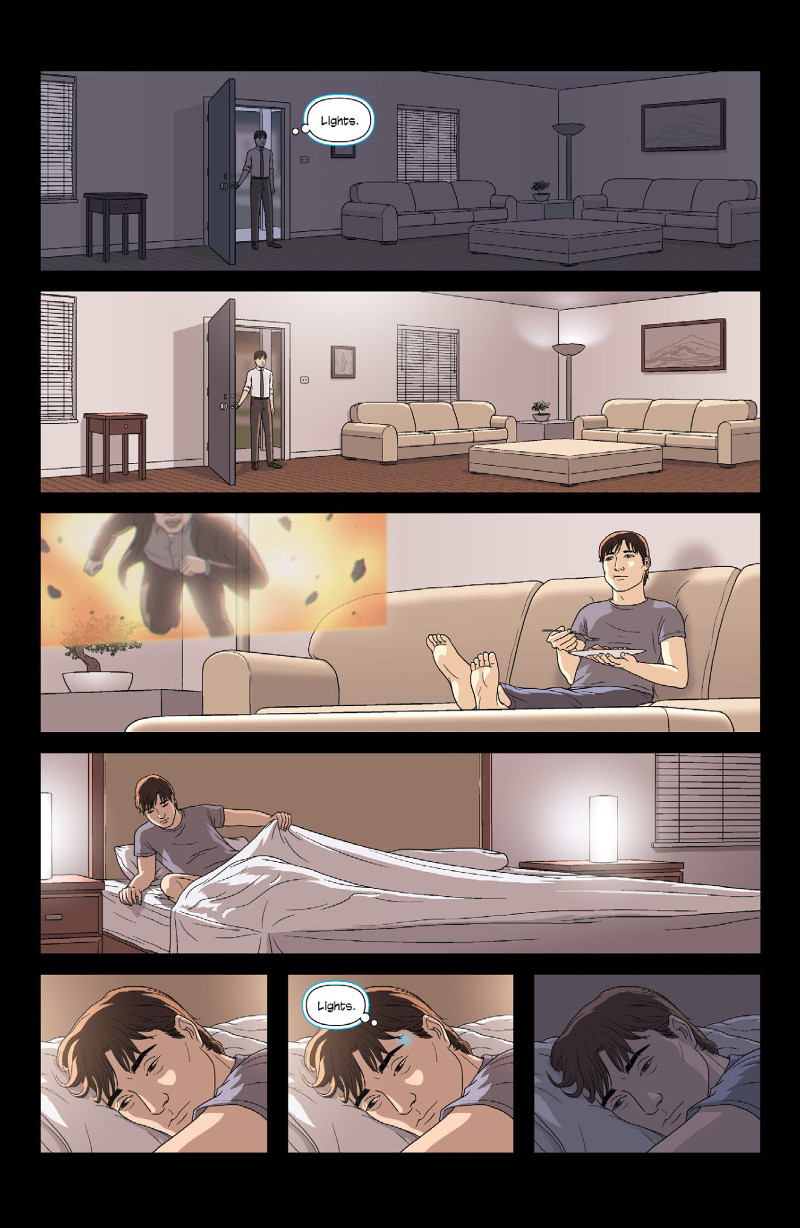 Jonathan: It’s a bit strange that I’ve been getting many comments about how my art style really fits this story. I pretty much haven’t been doing anything differently than my previous books. But ALEX + ADA is the first time I’ve done the art completely digitally. Maybe that’s it? It looks cleaner? I’m not sure it’s that apparent though. And I’m not sure that the book has minimal dialogue, as well. Maybe I’m just so inside a bubble that I can’t tell. All said, I don’t really give thought to how my art style fits with my/our writing.
Jonathan: It’s a bit strange that I’ve been getting many comments about how my art style really fits this story. I pretty much haven’t been doing anything differently than my previous books. But ALEX + ADA is the first time I’ve done the art completely digitally. Maybe that’s it? It looks cleaner? I’m not sure it’s that apparent though. And I’m not sure that the book has minimal dialogue, as well. Maybe I’m just so inside a bubble that I can’t tell. All said, I don’t really give thought to how my art style fits with my/our writing.
I really loved the story mechanics of the last issue, with Alex going through the entire term of the prison sentence over several pages, meaning he really had to earn his freedom. I know you had plotted everything out to start, but did you ever contemplate going a different route and going with a straight time jump? Or did you feel seeing Alex’s experience added weight to him eventually getting out?
Sarah: We thought of a ton of different ways to get to the end. But we wanted time to crawl while also speeding things along. We really wanted to show the consequences of everything Alex and Ada had previously done.
I really liked how you used Alex’s time in prison to take us through a sped up version of the android civil rights movement. Was that something you looked to history for guidance on how those types of things play out, or was it more the two of you thinking it out yourselves and creating your own history?
Sarah: Both. We definitely drew from past and current events. History has a tendency to repeat itself. But robot rights come with different sets of issues, and who knows if we’ll even come close to the future!
One of my favorite things in the last issue was the parallel between Alex taking his sentence without selling out anyone around him and Ada’s sacrifice of hiding her identity to protect Alex, despite it being a prison for her. It was beautifully handled, and a great look example of the love story at the core of this book. Would you say that, deep down, that’s what this book was? A love story? What appealed to you about telling a story like that in comic form?
Jonathan: It’s absolutely a love story. In many ways. Personally, I didn’t have a mission to tell a love story particularly in comic form. I’m just naturally drawn to working in drama, I’ve always wanted to tell a straight-up love story, and comics is my preferred medium to work in.
Sarah: It’s no secret that romance is my favorite genre. My mission is to tell as many love stories as possible. But there are also many kinds of love, and Jon and I really wanted to show different relationships, not just romance.
I was genuinely surprised by the revelation that Isabel was the one who sold out Alex, not Jacob. Would you say her taking that desperate gamble was the two of you showing the funhouse mirror reflection of what love can look like?
Jonathan: That is actually one of the previously mentioned ways that ALEX + ADA is a love story. But, mainly, it’s about what I mentioned before. Isabel represents a side of the world’s point of view on robots–jealously and fear of being replaced.
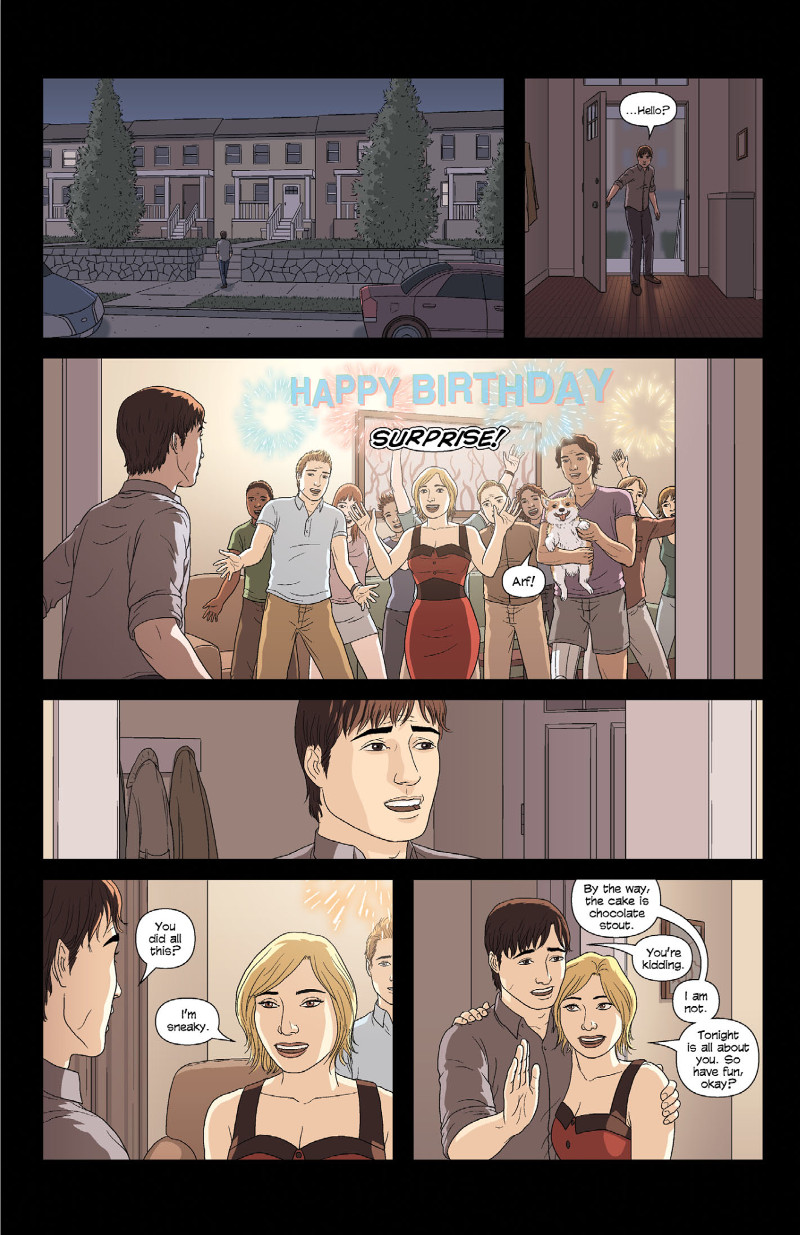 It seems every time I see someone talking about Alex + Ada on social media, it’s them mentioning that the latest issue made them cry. As creators, is driving an emotional reaction like that something you take pride in? Are you hoping that where you leave your readers leaves them with tears of joy?
It seems every time I see someone talking about Alex + Ada on social media, it’s them mentioning that the latest issue made them cry. As creators, is driving an emotional reaction like that something you take pride in? Are you hoping that where you leave your readers leaves them with tears of joy?
Jonathan: It’s a goal of mine to make moving stories, for the readers to have an emotional connection to the story. Those are the kinds of stories I enjoy.
Sarah: We never wrote a scene with the goal of making readers cry. But we certainly hoped we told the story in a way that resonated with people. I will absolutely admit that, in a really twisted way, people crying over scenes in the book warmed my heart.
People love creating sequels for everything, but this book felt complete in a way that few do. Was that the last time you’ll dig in to the world of these characters?
Sarah: Never say never, but one of the reasons I wanted to work with Jon is because we both share the same love of finite, complete stories. I’m excited to explore new worlds, as much as I miss this one.
Now that you’ve completed the journey, what’s your biggest takeaway from the experience? As creators, do you feel you learned anything from it that you’ll carry on to future projects?
Jonathan: Working on this book has taught me even a little bit more about the diversity of people in our actual world. I’m sure it’ll have some effect on my future work, even in the slightest.
Sarah: Alex + Ada pretty much taught me how to create a comic book from the ground up. It’s been a huge learning experience. I’m also hopeful that people will want to read more love stories.
Lastly, any plans to collect the whole series into a single volume? I feel like that would be a pretty popular item.
Sarah: It’s definitely something we’re looking into!
